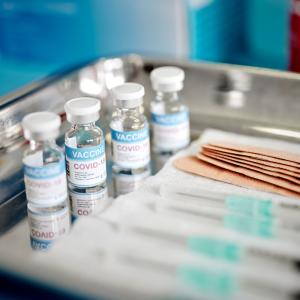
Photo: JUAN GAERTNER/SCIENCE PHOTO LIBRARY/Getty
An early study in human cells found that an antiviral drug candidate, Pfizer Inc.’s PF-00835231, may be at least as potent as the drug remdesivir in blocking the reproduction of the virus that causes 2019 coronavirus disease (COVID-19).
PF-00835231 was shown in preliminary research conducted by NYU Grossman School of Medicine and Pfizer to block the action of the viral enzyme 3CLpro (Mpro). This protease cuts up precursors into working proteins necessary for the reproduction of pandemic virus, severe acute respiratory syndrome coronavirus 2 (SARS-CoV-2).
Remdesivir works differently. As a nucleoside analog, it is woven into viral genetic material by the enzyme polymerase, which stops SARS-CoV-2 from copying itself inside human cells. Having been shown to reduce the length of hospital stays in patients with severe respiratory distress, remdesivir is currently the only antiviral drug authorized for emergency use against COVID-19.
The new study found that, in one set of cell culture experiments, PF-00835231 was statistically more potent in blocking the replication of the pandemic virus (it took 3.3 times more remdesivir than PF-00835231 to fully suppress replication). In a second, arguably more relevant cell model (a three-dimensional reconstruction of the human airway), the researchers found that both treatments were equally effective at blocking viral replication.
Posted recently on the preprint server bioRxiv, the study was done in cell culture (including the 3D airway model), cells grown for study in dishes of nutrients, researchers say. Such studies can reveal cellular mechanisms and provide a first look at drug potency, but whether PF-00835231 is effective as a treatment for SARS-CoV-2 infection would need to be confirmed ultimately in human clinical studies.
“Our study provides initial evidence that PF-00835231 is a potentially effective antiviral drug for COVID-19, and paves the way for further studies with this compound,” says corresponding study author Meike Dittmann, PhD, assistant professor in the Department of Microbiology at NYU Langone Health. “As the two compounds, PF-00835231 and remdesivir, appear to work differently, the hope is that their effects may be additive, shutting down the viral life cycle at more than one step like the drug cocktails designed over decades to counter HIV and the hepatitis C virus.”
The study results also demonstrated that PF-00835231 was effective at blocking SARS-CoV-2 replication in cell studies (in vitro) at 10 to 100 times lower concentrations than other drugs targeting 3CLpro that are currently in development, say the researchers. Still other experiments suggested that both PF-00835231 and remdesivir block viral replication of the two major viral lineages (clades) currently causing infections in the United States.
“While many studies are underway, the current arsenal of specific antiviral drugs against SARS-CoV-2 is extremely limited,” says first author Maren de Vries, PhD, a postdoctoral scholar in Dr. Dittmann’s lab. “The development of a diverse toolbox with different targets to combat SARS-CoV-2 will be important in controlling this disease.”
The work is moving more quickly because of work done with 3CLpro inhibitors during the 2003 outbreak of SARS, a relative of the current pandemic virus, which infected 8,098 people globally and killed 774. At that time, the disease declined so quickly that clinical studies were not practical, and so PF-00835231 was never tested clinically. The main protease of the viruses from the 2003 outbreak and the current pandemic are 96 percent identical at the level of their amino acid molecular building blocks, say the authors.
More Than One Mechanism
Pfizer designed, manufactured, and supplied PF-00835231. NYU Langone researchers performed the study experiments, building on their extensive research with influenza to design one of the first airway cell culture model systems for the study of SARS-CoV-2.
For the current study, the research team treated the cultured cells with PF-00835231 and remdesivir, and then infected them with SARS-CoV-2 in a secure biosafety facility. After giving the virus a short time to infect cells and replicate, the team used a technique called immunofluorescence using a microscope to count how many airway cells had been infected in one model, and how many new viral particles were shed by infected cells in another.
Both PF-00835231 and remdesivir decreased the overall number of infected cells, or the amount of progeny virus shed by infected cells, along with decreasing observable structure changes in cells known to accompany infection.
Along with Dr. Dittmann and Dr. de Vries, study authors at NYU Grossman School of Medicine were co-first author Adil Mohamed, Rachel Prescott, Ana Valero-Jimenez, and Ludovic P. Desvignes, PhD. Study authors also included Rebecca O’Connor and Claire Steppan at Pfizer Discovery Sciences in Groton, Connecticut; Annaliesa Anderson of Pfizer Vaccine Research and Development in Pearl River, New York; and Joseph Binder of Pfizer Oncology Research and Development in San Diego.
The study was funded by Pfizer, the National Institute of Allergy and Infectious Diseases, part of the National Institutes of Health, and the Jan Vilcek/David Goldfarb Fellowship Endowment Funds. The study funding provided by contract from Pfizer is being managed in accordance with the policies and practices of NYU Langone. In addition, the posted study manuscript is currently undergoing scientific peer review for potential publication.
Media Inquiries
Greg Williams
Phone: 212-404-3500
gregory.williams@nyulangone.org

